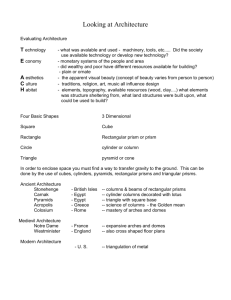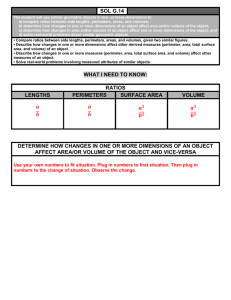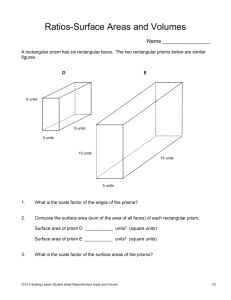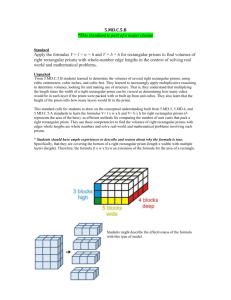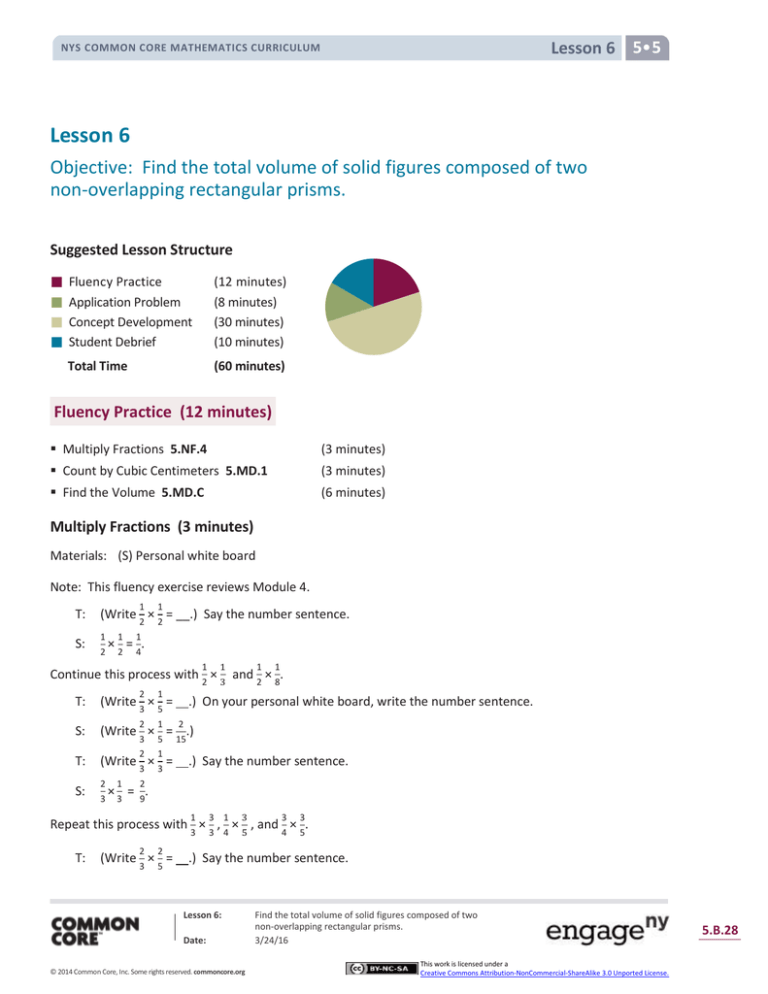
Lesson 6 5•5
NYS COMMON CORE MATHEMATICS CURRICULUM
Lesson 6
Objective: Find the total volume of solid figures composed of two
non-overlapping rectangular prisms.
Suggested Lesson Structure
Fluency Practice
Application Problem
Concept Development
Student Debrief
(12 minutes)
(8 minutes)
(30 minutes)
(10 minutes)
Total Time
(60 minutes)
Fluency Practice (12 minutes)
Multiply Fractions 5.NF.4
(3 minutes)
Count by Cubic Centimeters 5.MD.1
(3 minutes)
Find the Volume 5.MD.C
(6 minutes)
Multiply Fractions (3 minutes)
Materials: (S) Personal white board
Note: This fluency exercise reviews Module 4.
1
2
1
.
4
1
2
T:
(Write × = __.) Say the number sentence.
S:
1 1
×
2 2
=
1
1
1
1
Continue this process with 2 × 3 and 2 × 8.
2
1
2
1
2
1
T:
(Write 3 × 5 =
.) On your personal white board, write the number sentence.
S:
(Write 3 × 5 = 15.)
T:
(Write 3 × 3 =
S:
2 1
×
3 3
2
.) Say the number sentence.
2
9
= .
1
3 1
3
3
3
Repeat this process with 3 × 3 , 4 × 5 , and 4 × 5.
T:
2
2
(Write 3 × 5 =
.) Say the number sentence.
Lesson 6:
Date:
© 2014 Common Core, Inc. Some rights reserved. commoncore.org
Find the total volume of solid figures composed of two
non-overlapping rectangular prisms.
3/24/16
This work is licensed under a
Creative Commons Attribution-NonCommercial-ShareAlike 3.0 Unported License.
5.B.28
Lesson 6 5•5
NYS COMMON CORE MATHEMATICS CURRICULUM
S:
2
3
2
4
× 5 = 15.
3
3
Continue this process for 4 × 5.
T:
S:
T:
S:
1 3
× = .) On your personal white
5 4
1 3
3
(Write 5 × 4 = 20.)
3 4
(Write 4 × 3 = .) Write the equation.
3 4 12
(Write 4 × 3 = 12 = 1.)
(Write
Continue with the following possible sequence:
board, write the equation.
2 3 5
× ,
3 4 8
2
Count by Cubic Centimeters (3 minutes)
Note: This fluency activity will prepare students for today’s
lesson.
T:
S:
T:
S:
T:
S:
T:
S:
2
3
× 3 , and 5 × 8.
Count by twos to 10. (Write as students count.)
2, 4, 6, 8, 10.
Count by two-hundreds to 1,000. (Write as students
count.)
200, 400, 600, 800, 1,000.
Count by 200 cm3 to 1,000 cm3. (Write as students
count.)
200 cm3, 400 cm3, 600 cm3, 800 cm3, 1,000 cm3.
Count by 200 cm3. This time, when you come to
1,000 cm3, say 1 liter. (Write as students count.)
200 cm3, 400 cm3, 600 cm3, 800 cm3, 1 liter.
2
4
6
8
10
200
400
600
800
1,000
200 cm3
400 cm3
600 cm3
800 cm3
1,000 cm3
200 cm3
400 cm3
600 cm3
800 cm3
1 liter
200 cm3
400 cm3
600 cm3
800 cm3
1000 cm3
200 cm3
NOTES ON
MULTIPLE MEANS
400 cm3 600 cm3 800 cm3 1 liter
OF REPRESENTATION:
Have students skip-count as a group as
they did in Grades K and 1 when they
were counting by twos and threes.
This time, when they get to 1,000 cm3,
they should say 1 liter.
Find the Volume (6 minutes)
Materials: (S) Personal white board
Note: This fluency activity reviews Lesson 4.
T:
S:
T:
S:
T:
S:
(Project a 3 cm by 4 cm by 2 cm rectangular prism.)
What’s the length of the rectangular prism?
3 cm.
What’s the width?
4 cm.
What’s the height?
2 cm.
Lesson 6:
Date:
© 2014 Common Core, Inc. Some rights reserved. commoncore.org
Find the total volume of solid figures composed of two
non-overlapping rectangular prisms.
3/24/16
This work is licensed under a
Creative Commons Attribution-NonCommercial-ShareAlike 3.0 Unported License.
5.B.29
Lesson 6 5•5
NYS COMMON CORE MATHEMATICS CURRICULUM
T:
S:
(Write __ cm × __ cm × __ cm = __ cm3.) On your
personal white board, calculate the volume.
(Write 3 cm × 4 cm × 2 cm = 24 cm3.)
Repeat the process for the 4 cm by 4 cm by 10 cm rectangular
prism.
T:
S:
T:
S:
T:
S:
T:
S:
(Project the rectangular prism that has a given volume
of 40 in3, length of 4 in, and width of 5 in.) What’s the
length of the rectangular prism?
4 in.
What’s the width of the rectangular prism?
5 in.
What’s the volume of the rectangular prism?
40 in3.
(Write 40 in3 = 4 in × 5 in × __ in.) On your personal
white board, fill in the missing side length. If you need
to, write a division sentence to calculate your answer.
(Write 40 in3 = 4 in × 5 in × 2 in.)
Repeat the process for the rectangular prism with a given volume
of 120 in3, length of 3 in, and width of 4 in.
T:
S:
T:
S:
T:
S:
(Project the rectangular prism with a face having a given
area of 30 ft2 and a given width of 6 ft.) Say the given
area of the prism’s front face.
30 ft2.
Say the given width.
6 ft.
(Write V = __ ft3.) On your personal white board,
calculate the volume.
(Write V = 180 ft3.)
Repeat the process for the rectangular prism with a face having a
given area of 12 ft2 and a height of 8 ft.
Concept Development (30 minutes)
Materials: (T) Drawing of rectangular prism figures
(S) 15 centimeter cubes, dot paper
Lesson 6:
Date:
© 2014 Common Core, Inc. Some rights reserved. commoncore.org
Find the total volume of solid figures composed of two
non-overlapping rectangular prisms.
3/24/16
This work is licensed under a
Creative Commons Attribution-NonCommercial-ShareAlike 3.0 Unported License.
5.B.30
Lesson 6 5•5
NYS COMMON CORE MATHEMATICS CURRICULUM
Problem 1
Build and combine structures, and then find the total volume.
T:
S:
T:
S:
T:
S:
T:
S:
T:
S:
Partner A, use one color cube to build a structure that is 3 cm by 2 cm by 2 cm. Partner B, use a
different color to build a cube that is 2 cm long on every side. Record the volume of your structures.
(Work.)
Keeping their original dimensions, how could you combine the two structures you’ve built? Turn
and talk. Then, find the volume of your new structure.
We could put the cube on top of the rectangular prism.
Possible Combinations
We could put them beside each other on the end.
We could make an L. The volume is 20 cubic
units.
Now, build a different structure using the two prisms,
and find the volume.
(Work.)
How did you find the volume of your new structures?
We counted all the blocks. We knew that one was
12 cubic units and the other one was 8. We just added
that together to get 20 cubic units.
When you built the second structure, did the volume
change? Why or why not?
It did not change the volume. There were still 20 cubic
units. It doesn’t matter how we stacked the two
prisms together. The volume of each one is the same
every time, and the volume of the whole thing is still
20 cubic units. The total volume is always going to
be the volume of the red structure plus the volume of
the green structure, no matter how we stack them.
Problem 2
T:
S:
T:
S:
(Project or draw on the board the 3 m × 2 m × 7 m prism on the
7m
right.) What is the volume of this prism?
3
42 m .
Imagine another prism identical to this one. If we glued them
2m
together to make a bigger prism, how could we find the
3m
volume? Turn and talk. Then, find the volume.
We already know that the volume of the first one is 42 m3. We could just add another 42 m3 to it.
That would be 84 m3. We could multiply 42 by 2 since they are just alike.
That’s 84 m3.
Lesson 6:
Date:
© 2014 Common Core, Inc. Some rights reserved. commoncore.org
Find the total volume of solid figures composed of two
non-overlapping rectangular prisms.
3/24/16
This work is licensed under a
Creative Commons Attribution-NonCommercial-ShareAlike 3.0 Unported License.
5.B.31
Lesson 6 5•5
NYS COMMON CORE MATHEMATICS CURRICULUM
Problem 3
T:
S:
T:
S:
T:
S:
T:
S:
T:
S:
T:
S:
(Project or draw on the board the composite structure.) How is
this drawing different from the last one?
There are two different size boxes this time. The little box on
top only has measurements on the length and the height.
There are a lot of markings on this figure. We’ll need
to be careful that we use the right ones when we find
the volume. Find the volume of the bottom box.
(Work to find 120 cubic inches.)
What about the one on the top? I heard someone say
that there isn’t a width measurement on the drawing.
How will we find the volume? Turn and talk.
The boxes match up exactly in the drawing on the
width. That means the width of the top box is the
same as the bottom one, so it’s still 5 inches wide.
You can tell the top and bottom box are the same
width, so just multiply 3 × 5 × 2.
What is the volume of the top box?
30 cubic inches.
How could we find the total volume?
Add the two together.
Say the number sentence with the units.
120 cubic inches + 30 cubic inches = 150 cubic inches.
2 in
3 in
4 in
5 in
6 in
NOTES ON
MULTIPLE MEANS
OF ENGAGEMENT:
Continuing to use the cubes to
construct the prisms can help to keep
kinesthetic learners on task. The
calculation of the volume can still be
made with the formula.
Problem 4
T:
S:
T:
S:
T:
S:
(Project or draw the figure given on the right.)
4m
Compare this figure to the last one.
There are two different boxes again. There’s a little
4m
one and a big one, like last time. This time, there’s a
2m
bracket on the height of both boxes. There’s no
2m
length or width or height measurement on the top box
6m
this time.
If there are no measurements on the top box alone, how might we still calculate the volume? Turn
and talk.
We can tell the length of the top box by looking at the 6 meters along the bottom. The other box
has 4 meters sticking out on the top of the box. That means the box must be 2 meters long. The
length is 6 minus 4. That’s 2. The width is easy. It’s the same as the bottom box, so that’s
2 meters. The height of both boxes is 4 meters. If the bottom box is 2 meters, then the top box
must also be 2 meters.
What is the volume of the top prism? Say the number sentence.
2 m × 2 m × 2 m = 8 cubic meters.
Lesson 6:
Date:
© 2014 Common Core, Inc. Some rights reserved. commoncore.org
Find the total volume of solid figures composed of two
non-overlapping rectangular prisms.
3/24/16
This work is licensed under a
Creative Commons Attribution-NonCommercial-ShareAlike 3.0 Unported License.
5.B.32
Lesson 6 5•5
NYS COMMON CORE MATHEMATICS CURRICULUM
T:
S:
T:
S:
What is the volume of the bottom prism? Say the
number sentence.
6 m × 2 m × 2 m = 24 cubic meters.
What’s the total volume of both? Say the number
sentence.
8 cubic meters + 24 cubic meters = 32 cubic meters.
Problem 5
Two rectangular prisms have a combined volume of 135 cubic
meters. Prism A has double the volume of Prism B.
a. What is the volume of each prism?
b. If one face of Prism A has an area of 10 square meters, what
is its height?
T:
NOTES ON
MULTIPLE MEANS
OF ENGAGEMENT:
Challenge students whose spatial skills
allow them to see these figures easily
by having them draw a figure
consisting of three different prisms on
dot paper with just enough
information given to calculate the
volume of the figure. They should
calculate the volume of their own
figure and then exchange figures with a
partner.
Students can write about the minimum
information necessary to calculate the
volume of a composite figure.
Let’s use a tape diagram to help us with this problem.
Read it with me.
T/S: (Read.)
T: What can we draw from the first sentence?
S: A tape diagram for each prism. Two tape
diagrams labeled Prism A’s volume and Prism B’s
volume. A bracket on both to show they are
135 cubic meters total. Their total volume is
135 cubic meters.
T: What does the next sentence tell us, and how can
we represent it?
S: Prism A is double the volume of Prism B. We
need 2 units for Prism A. Prism A’s tape should
be twice as long as Prism B’s.
T: Show that in your diagram. Then, use this
information to solve for the volumes of both
prisms.
S: (Work.)
T: What is the volume of each prism?
S: Prism A is 90 cubic meters, and Prism B is 45 cubic
meters.
T: To find the height of Prism A, what do we need to think
about? Turn and talk, and then solve.
S: We know the area of one face. If we multiply the area by something, we should get the volume of
90 m3. The area is 10 m2, and 10 times 9 is 90. It is 9 meters tall. We can divide 90 by 10 and get
9 meters tall.
Lesson 6:
Date:
© 2014 Common Core, Inc. Some rights reserved. commoncore.org
Find the total volume of solid figures composed of two
non-overlapping rectangular prisms.
3/24/16
This work is licensed under a
Creative Commons Attribution-NonCommercial-ShareAlike 3.0 Unported License.
5.B.33
Lesson 6 5•5
NYS COMMON CORE MATHEMATICS CURRICULUM
Application Problem (8 minutes)
A storage company advertises three different choices for all your storage needs: “The Cube,” a true cube
with a volume of 64 m3; “The Double” (double the volume of the cube); and “The Half” (half the volume of
the cube). What could be the dimensions of the three storage units? How might they be oriented to cover
the most floor space? The most height?
Note: Students use the knowledge that a cube’s sides are all equal to find the side as 4 meters.
(Side × side × side = 64 m3, so each side must be 4 m.) While students may approach halving or doubling the
other storage units using different approaches (for example, doubling any of the dimensions singly), this
problem affords an opportunity to discuss the many options of orienting the storage units to give the most
practical increase or decrease in square footage or height
for storage of various items. The problem also reinforces
the part to whole relationships of volume.
Problem Set (10 minutes)
Students should do their personal best to complete the
Problem Set within the allotted 10 minutes. For some
classes, it may be appropriate to modify the assignment
by specifying which problems they work on first. Some
problems do not specify a method for solving. Students
should solve these problems using the RDW approach
used for Application Problems.
Student Debrief (10 minutes)
Lesson Objective: Find the total volume of solid figures
composed of two non-overlapping rectangular prisms.
Lesson 6:
Date:
© 2014 Common Core, Inc. Some rights reserved. commoncore.org
Find the total volume of solid figures composed of two
non-overlapping rectangular prisms.
3/24/16
This work is licensed under a
Creative Commons Attribution-NonCommercial-ShareAlike 3.0 Unported License.
5.B.34
Lesson 6 5•5
NYS COMMON CORE MATHEMATICS CURRICULUM
The Student Debrief is intended to invite reflection and active processing of the total lesson experience.
Invite students to review their solutions for the Problem Set. They should check work by comparing answers
with a partner before going over answers as a class. Look for misconceptions or misunderstandings that can
be addressed in the Debrief. Guide students in a conversation to debrief the Problem Set and process the
lesson.
Any combination of the questions below may be used to
lead the discussion.
What advice would you give to a friend who
was having trouble picturing the dimensions
on a composite figure? What helps you to
figure out missing dimensions?
If all students use an addition strategy to find the
total volume of the figures, suggest to them the
alternate strategy of subtracting the missing part.
For example, Problem 1(d) offers such a strategy.
Ask students to imagine that the top prism was
once identical to the bottom prism (much like the
figure in Problem 1(a)). Ask: If these two prisms
were identical, what would the total volume be?
(360 cubic meters.) Now, imagine that the end
was removed from the top prism. What would
the volume of that removed part be?
(2 m × 3 m × 6 m = 36 cubic meters.) If we
wanted to know the total volume of the figure
with this part removed, how could we do that?
(Subtract. 360 m3 – 36 m3 = 324 m3.) Is this the
same volume we found when we added the two prisms? (Yes!)
How did the Application Problem help you solve Problem 3?
Compare your approach to solving Problem 4 with that of the person sitting next to you. How is your
thinking alike? How is it different?
Allow students to share the tape diagrams that they used to solve Problem 5. If students need more
scaffolding, use the suggested sequence in the Concept Development to guide their drawing. Ask:
How is the problem like the one we did together? How is it different? (It uses the word half instead
of double. This time, Prism B is the larger.) What was the effect on the height of the two prisms by
making the base of Prism B smaller than the one on Prism A?
Is a shorter container always a smaller volume? Give some examples of prisms to support your
answer.
Exit Ticket (3 minutes)
After the Student Debrief, instruct students to complete the Exit Ticket. A review of their work will help with
assessing students’ understanding of the concepts that were presented in today’s lesson and planning more
effectively for future lessons. The questions may be read aloud to the students.
Lesson 6:
Date:
© 2014 Common Core, Inc. Some rights reserved. commoncore.org
Find the total volume of solid figures composed of two
non-overlapping rectangular prisms.
3/24/16
This work is licensed under a
Creative Commons Attribution-NonCommercial-ShareAlike 3.0 Unported License.
5.B.35
Lesson 6 Problem Set 5•5
NYS COMMON CORE MATHEMATICS CURRICULUM
Name
Date
1. Find the total volume of the figures, and record your solution strategy.
a.
b.
7 in
3 in
5 cm
6 in
5 cm
4 in
15 in
3 cm
14 cm
Volume: ______________________________
Volume: ______________________________
Solution Strategy:
Solution Strategy:
c.
d.
8m
4 cm
6 cm
2 cm
12 m
6m
3 cm
10 cm
10 m
3m
Volume: ______________________________
Volume: ______________________________
Solution Strategy:
Solution Strategy:
Lesson 6:
Date:
© 2014 Common Core, Inc. Some rights reserved. commoncore.org
Find the total volume of solid figures composed of two
non-overlapping rectangular prisms.
3/24/16
This work is licensed under a
Creative Commons Attribution-NonCommercial-ShareAlike 3.0 Unported License.
5.B.36
NYS COMMON CORE MATHEMATICS CURRICULUM
Lesson 6 Problem Set 5•5
2. A sculpture (pictured below) is made of two sizes of rectangular prisms. One size measures 13 in by 8 in
by 2 in. The other size measures 9 in by 8 in by 18 in. What is the total volume of the sculpture?
3. The combined volume of two identical cubes is 128 cubic centimeters. What is the side length of each
cube?
4. A rectangular tank with a base area of 24 cm2 is filled with water and oil to a depth of 9 cm. The oil and
water separate into two layers when the oil rises to the top. If the thickness of the oil layer is 4 cm, what
is the volume of the water?
4 cm
5. Two rectangular prisms have a combined volume of 432 cubic feet. Prism A has
half the volume of Prism B.
a. What is the volume of Prism A? Prism B?
b. If Prism A has a base area of 24 ft2, what is the height of Prism A?
2
c. If Prism B’s base is 3 the area of Prism A’s base, what is the height of Prism B?
Lesson 6:
Date:
© 2014 Common Core, Inc. Some rights reserved. commoncore.org
Find the total volume of solid figures composed of two
non-overlapping rectangular prisms.
3/24/16
This work is licensed under a
Creative Commons Attribution-NonCommercial-ShareAlike 3.0 Unported License.
5.B.37
Lesson 6 Exit Ticket 5•5
NYS COMMON CORE MATHEMATICS CURRICULUM
Name
Date
Find the total volume of soil in the three planters. Planter A is 14 inches by 3 inches by 4 inches. Planter B is
9 inches by 3 inches by 3 inches.
3 in
in[G
3 in
C
13in
B
A
Lesson 6:
Date:
© 2014 Common Core, Inc. Some rights reserved. commoncore.org
Find the total volume of solid figures composed of two
non-overlapping rectangular prisms.
3/24/16
This work is licensed under a
Creative Commons Attribution-NonCommercial-ShareAlike 3.0 Unported License.
5.B.38
Lesson 6 Homework 5•5
NYS COMMON CORE MATHEMATICS CURRICULUM
Name
Date
1. Find the total volume of the figures, and record your solution strategy.
a.
b.
18 cm
13 in
3 cm
2 cm
2 in
4 in
5 in
2 in
9 cm
7 cm
21 cm
Volume: ______________________________
Volume: _______________________________
Solution Strategy:
Solution Strategy:
c.
d.
6 mm
12 m
4 mm
9m
4 mm
5 mm
11 m
8 mm
4m
5 mm
2m
3 mm
3 mm
10 m
Volume: ______________________________
Volume: _______________________________
Solution Strategy:
Solution Strategy:
Lesson 6:
Date:
© 2014 Common Core, Inc. Some rights reserved. commoncore.org
Find the total volume of solid figures composed of two
non-overlapping rectangular prisms.
3/24/16
This work is licensed under a
Creative Commons Attribution-NonCommercial-ShareAlike 3.0 Unported License.
5.B.39
NYS COMMON CORE MATHEMATICS CURRICULUM
Lesson 6 Homework 5•5
2. A planting box (pictured below) is made of two sizes of rectangular prisms. One type of prism measures 3
inches by 6 inches by 14 inches. The other type measures 15 inches by 5 inches by 10 inches. What is the
total volume of three such boxes?
3. The combined volume of two identical cubes is 250 cubic centimeters. What is the measure of one cube’s
edge?
4. A fish tank has a base area of 45 cm2 and is filled with water to a depth of 12 cm. If the height of the tank
is 25 cm, how much more water will be needed to fill the tank to the brim?
5. Three rectangular prisms have a combined volume of 518 cubic feet. Prism A has one-third the volume of
Prism B, and Prisms B and C have equal volume. What is the volume of each prism?
Lesson 6:
Date:
© 2014 Common Core, Inc. Some rights reserved. commoncore.org
Find the total volume of solid figures composed of two
non-overlapping rectangular prisms.
3/24/16
This work is licensed under a
Creative Commons Attribution-NonCommercial-ShareAlike 3.0 Unported License.
5.B.40


